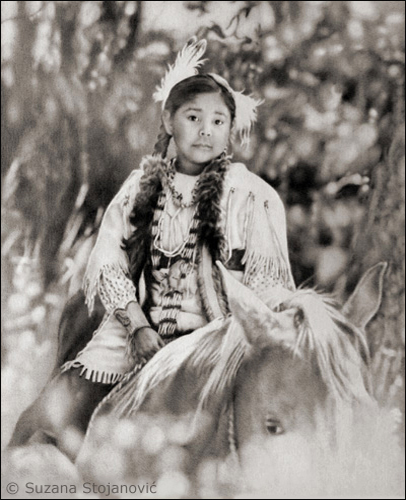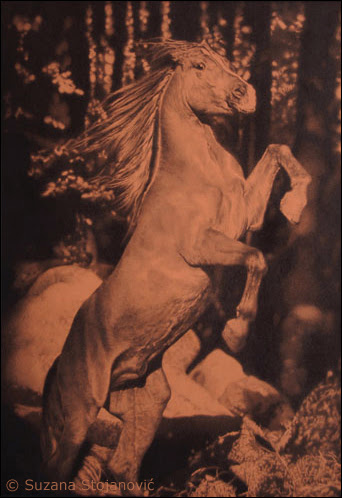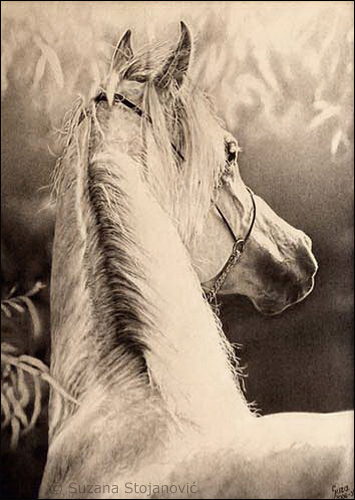“Connection” 2008.
30x24 cm
“Through the shadows” 2008.
33x41 cm
“Keeyana” 2008.
30x24 cm
“Fairies” 2007.
29x32 cm
“The call” 2007.
50x35 cm
“In clouds” 2007.
34x36 cm
“Sunset” 2006.
28x41 cm
“My way” 2006.
40x29 cm
۞
▪ Pencil drawings represent the basis of many works, and at the same time character and vision of the artists. Playing with brightness and with shadow, they in their galleries create figures of individuals and animals, and on their own way they form objects uniquely, which, from a certain angle of observation, motivates them to transfer them to paper or cardboard. These objects and figures they sometimes show so faithfully that, for moments, we seem to stand before statues or living beings and that we can touch them. “It is in this illusion that the power of graphite pencil is hidden”, says Suzana Stojanović, one of those who did not resist its silvery glint. Far from the chaos and noise of everyday life, on the cardboard, with her patience and precision, she is immortalized beautiful spaces, personalities and animals. “In this space, in which only contrasts are ruled, much of the new and interesting one can be discovered, which is often hidden below the color. Everything is clean and clear, like the city after the rain, on whose facades and streets we first notice what has stood for us for years, but we could not see it because of the dust. With its simplicity, the drawing touches the core of every matter. In life, we always have to start from something, and the pencil and paper are always at our hands”, says the author. As a child, she liked to draw floras. Their endless diversity constantly awoke her interest. Later, on the margins of her school notebooks, she often sketched animals. Considering that in her youth she was engaged in many techniques and among them engraving and sculpture, the knowledge of all these techniques had a great influence on the formation of her as an artist. Working on sculptures helped her to anatomically impeccable represent people and animals with pencils. One of her most famous drawings, which radiate incredible energy and expressiveness, is “In clouds”. Everything on this composition, full of dynamics, is dramatic, and, as we observe, it seems to us that the drama will flow into the space outside its frames. A powerful and upset animal is a central figure of this unique moment that takes place in the clouds. The struggle of brightness and shadow fades under its hooves. The being, melancholy view, is diverged from the ground and goes to some unknown sphere toward the sky. Gently shaded, soft celestial rugs, far from the cruelty of everyday life, bring some new life, unpredictable, but at the same time attractive. Detailed drawn equipment and the body of the animal contrast with the vague clouds that disappear in the whirlwind of movement. This artwork is one of those Suzana does not do with a black pencil, trying to soften the gradations between the dark and the bright zone and to enhance the naturalness of the subject, adding a note of mystery that sometimes seems incomprehensible and inexplicable to the observers. She is very creative and almost never repeats themes in both her visual and literary works. Unlike most artists who turn their experiences and perceptions into black-and-white displays, she does not draw only on white cardboard because she is of the opinion that the impressions that everyday scenes leave on us are not always the same intensity, but “everything is in the crossing of myriad vertical, horizontal, diagonal and winding lines. They speak much more than contrast, volume, shading, and sharp gradations”. The upright lines in her opinion resemble the pillars and associate those with strength, power and endurance (“The call”). The being, which prances, the trees of the deep forest in the background follow, and thus contribute to a monochrome show, that leaves breathless. This illustration is an example to show that the artist pays great attention to the proportions of the subject, which are almost mathematically correct. However, the impulsiveness, which comes from the depths of her being, overcomes the strength of a powerful animal. Suzana Stojanović with pencil is emphasizing the forms of full expression and volume by long shading and rare sharp gradations. In her gallery, you can sometimes see drawings made with dots (“Through the shadows”), whose structure is visible in the freckles that cover the body of the wonderful being and in the background filled with blurred circles, deliberately shaded a bit roughly to intensify the fineness and beauty of the animal. What is characteristic of all of her pencil works is the balance. Nothing on the side can distract the observer from the main subject. She unobtrusive highlights individual parts of the drawings, making them more important than others. By precise positioning of the main subject and by skillfully highlighting the focal point, she attracts the watcher’s view. Work “My way” consists of two parts that connect with a distinct line that draws the head and neck of the animal. The gentle light of the morning, in which the leaves and the profile of the beautiful being are bathed, announces the beginning of a new day and the path to which its gaze is directed. The observer does not know how this path looks, but Suzana with the pencil initiated his curiosity, and he identifies this path with some of his visions, desires and aspirations. “The ways have no beginnings and ends. They gather and split, but they all go somewhere. Even when you come to dead-end, you can always turn back and you are again on the new way. In the life of every artist, days happen when it seems that his creative enthusiasm will dry up at any moment and that his work will come to a dead end. The only way to get out of it is to look for the brightness, and if he is persistent enough and motivated, he will find it”, says the author “because everything in life, as well as in the drawing, is based on contrasts. All those outlines and sketches, made in different places and at different times, piled up in us, always find the way to go out. Sometimes they are not the way we see them, but they are always the kind we imagine. It is the ray that scatters the lines of the horizons of creation and opens the spaces of deep thinking and constant variability of mood. The sketching of various places and events is the only way of not letting them escape and not allowing them to transform into something quite the opposite of what the artist attended and what motivated him. His precise transmission of everything he sees before him with a pencil on a cardboard will keep from forgetting many links of the chain to which we all belong.” In one of her studies, Suzana explains why it is important to draw with a pencil: “It is the best way to understand the shape (whether it’s geometric or organic), the volume and anatomy of the body (whether it’s humans or animals), their gesticulation and the texture of many objects that the creator wants to present. Only with the help of drawing, we can understand the rhythm and expression of phenomena and concepts. Sometimes, just a few lines are enough to create a masterpiece, and sometimes the long-term work becomes nonsensical if it is not matched. Drawing is the beginning of every creative display and any artist should not avoid it, even if it were just the contours of what he wants to show and say. At the moment, when the pencil in his hands becomes a fountain pen, he is on the right path to write a successful story.” Unusual stories, which she writes with her own language on smooth and rough cardboard, erase the boundaries of the epochs. All of her drawings connect on the one hand the spontaneity and complete credibility of what has been presented, and on the other, the beautification of truth and reality, which, often, in all of us arouses restlessness and trepidation. Work “Sunset”, like the work “Connection”, symbolizes the connection of two beings, but at the same time the inevitability to which they are going. Their views, turning towards the sun which setting, seem to announce the end of a story. The half-dark scene is permeated with melancholic calmness. The winding lines of their twisted manes show some kind of not opposing to the events that coming. This peace is disturbed only by the gentle breeze, perceived in the rolling branches, which, as if for the last time trying to go to the sun. Bare, without leaves, they leave the impression of transience, which none of us, no matter how hard we try, cannot resist. Many of the creative souls, printed on paper and left to the first wind, were not able to resist this transience to take them in an unknown direction. The artworks of Suzana Stojanović are recognizable by interweaving the past and present, joy and sorrow. Inaccessible areas cause different emotions and admiration. With her art, she emphasizes the beauty of diversity, both human and animal. The subjects in her illustrations are characterized by expressiveness and sophistication. She does not idealize characters, and they do not have religious sublimity; these are quite ordinary people, unknown to the public (works “Keeyana” and “Friends”), riders who never separate from their companions, either in good or bad. The lives of these people can only be perceived by their views directed at observers. The compassionate realism and the atmosphere of spiritual warmth emerging from their view revive characters, but the composition, poses and gestures of the figures bring into it, at first glance an idyllic, atmosphere, note of disquietude and anticipation. What is interesting about these works is the clothes of these people, very detailed represented in graphite pencils on the cardboard, and it, at first glance, explains the areas they belong to. The atmosphere is complemented by animals, characteristic of these areas. With these works (which can also be viewed in DeviantArt, Behance and ArtStation gallery), Suzana shows that she does not like emptiness because they are poor in her opinion. She always enriches her artistic spaces with interesting particulars, such as a falcon that feels secure at the man’s hand. “All the forms that are found in his view, consciously or unconsciously, the artist always in some way presents with interrupted and full lines, which only he can fully understand. They are always different and, no matter how hard he tries, he can never repeat them. That’s the charm of drawing”, she says.









